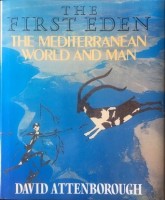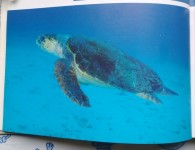 Tytuł: The First Eden: The Mediterranean World and Man
Tytuł: The First Eden: The Mediterranean World and Man
Autor(zy): David Attenborough
Rok wydania: 1987
Wydawnictwo: Collins / BBC Books
Dlaczego w bazie: W książce tej, poświęconej morzu śródziemnemu, jest kilka żółwich kawałków + dwa ładne zdjęcia.
Pierwsza wzmianka jaką przytaczamy dotyczy dwóch gatunków żółwi wymienionych jako przypływający z oceany atlantyckiego do morza śródziemnego, Żółw Skórzasty oraz Żółw Karetta. Pojawia się też informacja, że na paru greckich wyspach i w części tureckiego wybrzeża składają jajka, niektóre żółwie zaś się zadomowiły i w ogóle morza śródziemnego nie opuszczają.
Other Atlantic animals also pay regular visits to the Mediterranean. The immense ocean-going leatherback turtle, which can grow to a lenght of six feet, whose global wanderings are still largely uncharted sometims appears in the Sea, drifting through the water lazily browsing on sholas of jellyfish. Loggerhead turtles, which are very smaller, come in to feed on the Posidonia meadows. Some haul themselves out of the water to lay theirs eggs in the sand of beaches around one or two of the Greek islands and along the remoter parts of the Turkish coast. A significant number have even become permanent residents and never leave the Sea at all.
Druga wzmianka to opis zdjęcia żółwia morskiego (Karetta), wyjaśnione jest, że żółwie są gadami i chociaż są w stanie długo przebywać w zanużeniu, to w końcu muszą się wynurzyć by zaczerpnąć powietrza.
Newcomers to the Sea
Several groups of air-breathing land animals have produced species that have colonised the sea. The turtles, such as the loggerhead (below), are reptiles. They are able to stay below the surface for long periods, but eventually they have to come to the surface to breathe.
Kolejny element to luźna wzmianka, że wyspy zostały zasiedlone przez rozmaite zwierzęta, wymieniane sa m.in. żółwie.
Certain it is, however, that soon after the refilling, all the islands of any size were inhabited by a range of animals that included between them mice and shrews, hedgehogs and deer, tortoises and land birds, and even hippopotamus and elephants. None, however, had any large carnivores such as lion or leopard, and the their absence was to become important.
Kolejny kawałek dotyczy maltańskich żółwi, porównywalnych rozmiarami z tymi jakie współcześnie żyją na Galapagos i Aldabrze. Wyjaśniony jest też mechanizm pozwalający na taki gigantyzm.
Other Maltese animals, however, had become giants. There was a huge swan with a nine-foot wing-span which, judging from the small size of the breast bone to which its flying muscles were attached, was probably almost flightless, a dormouse the size of a large rabbit, and tortoises full comparable in size to those living today on the Galapagos and on Aldabra in the Indian Ocean. Birds escape their land-bound enemies by flying, rodents by taking refuge down holes and crevices. Both these factors normally limit their size. But in the absence of all enemies, both animals are free to grow large. The swans probably had relatively few problems with food, since little else competed with them for their favoured diet of water plants, but this would not have been the case as far as the rodents and tortoises were concerned. Competition for limited food supplies, it seems, has a different effect on small species than it does on large ones. Individual undersized elephants may well survive when bigger ones starve; but a big mouse or tortoise is likely to be more successful at claiming a share of scarce grazing than a small one.
Przedostatni kawałek to wyjaśnienie dlaczego gady tak dobrze sobie radzą w klimacie morza śródziemnego, z jednoznacznym zaznaczeniem, że żółwie można znaleźć właściwie wzdłuż całego wybrzeża.
Reptiles, however, relish the summers. Their skins are watertight, so the danger of dehydration for them is a negligible one. Furthermore, they gather the heat they need to activate the chemistry of their bodies d ever it directly from their environment instead of using food to generate it as mammals do, so warm days give them more energy rather than robbing them of it. In consequence, reptiles of one kind o another are common. Tortoises are found around most of the Sea’s coastline.
Ostatni kawałek to drugie zdjęcie, przedstawia „spur-thighed” żółwia, który po polsku zwie się bardzo adekwatnie, Żółw śródziemnomorski. Sam podpis mówi, że w omawianym rejonie znaleźć można trzy gatunki żółwia, ten ze zdjęcia jest najpowszechniejszy, występuje w Grecji, Turcji, Włoszech a także na afrykańskim wybrzeżu.
There are three species of tortoise of which the spur-thighed (3) is the mos widespread, being found in Greece, Turkey and Italy as well as along the African shore.


Autor: XYuriTT
